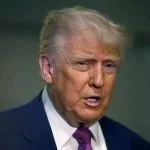
(NEW YORK) — The United States’ economic growth forecast was cut sharply on Tuesday by the Organization for Economic Co-operation and Development, or OECD, which attributed the gloomy outlook in part to tariffs issued by President Donald Trump.
The OECD expects the U.S. economy to grow 1.6% in 2025, marking a substantial reduction from a 2.2% expansion forecast in March.
The nation’s economic growth will slow further in 2026, the OECD said, cutting its forecast for that year to 1.5%.
The dampened outlook for the U.S. mirrors a slowdown expected for the global economy, the OECD said, predicting global economic growth to fall from 3.4% in 2024 to 2.9% in 2025.
“Global economic prospects are weakening,” the OECD said in a statement, pointing to an array of factors that includes “substantial barriers to trade” and “heightened policy uncertainty.”
The OECD also warned of a potential upsurge in U.S. consumer prices, saying inflation could approach 4% by the end of 2025. The inflation rate currently stands at 2.3%.
“Higher trade costs, especially in countries raising tariffs, will also push up inflation,” the OECD said.
The OECD forecast echoes concerns raised by Wall Street analysts and Federal Chair Jerome Powell about the possibility that President Donald Trump’s tariffs may cause what economists call “stagflation,” which is when inflation rises and the economy slows.
A growing set of major retailers have warned of possible tariff-driven price hikes, including Nike, Target, Walmart and Best Buy.
Consumer attitudes have soured for four consecutive months as tariffs have taken hold, according to a survey conducted by the University of Michigan.
Consumer spending, which accounts for about two-thirds of U.S. economic activity, could weaken if shopper appetites diminish. In theory, a slowdown of spending could hammer some businesses, prompting layoffs that in turn further shrink consumer activity.
“Global trade tensions are hitting sentiment,” the OECD said.
U.S. tariffs remain above where they stood before Trump’s second term began, but a number of levies have rolled back in recent weeks.
A trade agreement between the U.S. and China last month slashed tit-for-tat tariffs between the world’s two largest economies and triggered a surge in the stock market. Within days, Wall Street firms softened their forecasts of a recession.
The U.S.-China accord came weeks after the White House paused far-reaching “reciprocal tariffs” on dozens of countries. Trump also eased sector-specific tariffs targeting autos, and rolled back duties on some goods from Mexico and Canada.
Trump’s steepest tariffs fell into legal limbo last week, casting uncertainty over a major swath of the president’s signature economic policy.
For now, key measures of the economy remain fairly strong.
The unemployment rate stands at a historically low level and job growth remains robust, though it has slowed from previous highs. In recent months, inflation has cooled, reaching its lowest level since 2021.
Copyright © 2025, ABC Audio. All rights reserved.
